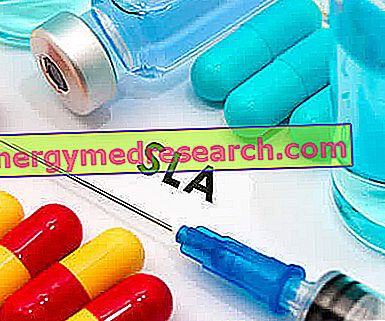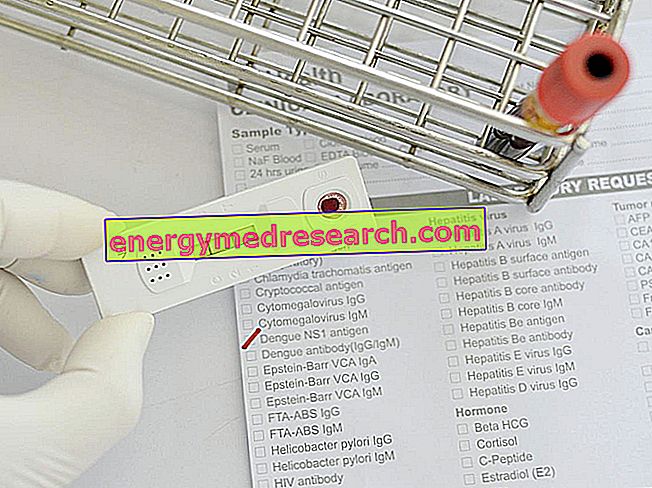Generality
Ovulation and fertility are two themes that are closely related to each other and that arouse the interest of many women, especially those intending to get pregnant. Moreover, within the menstrual cycle, ovulation represents the moment of maximum female fertility.

Review of oogenesis
With development during the 28 days of the menstrual cycle, oogenesis is the process of production and maturation of an egg cell, by one of the two ovaries .
The highlights of oogenesis are basically three: the follicular phase, the ovulatory phase (or ovulation ) and the luteal phase .
- The starting point of oogenesis, the follicular phase is the moment in which the ovaries, after a precise hormonal stimulation, produce and bring to maturity, inside a follicle, the future egg cell (or primitive egg cell ).
The follicular phase covers the first 14 days of the menstrual cycle (NB: the first day of menstruation indicates the first day of a menstrual cycle).
- Immediately after the follicular phase, the ovulatory phase is the moment in which, following a hormonal stimulus different from the previous one, the now mature egg cell detaches from the follicle (and from the ovary) and nestles in the fallopian tubes, ready to meet with a possible spermatozoon .
Ovulation lasts one day and is generally between the 14th and 15th day of the menstrual cycle.
- Finally, beginning immediately after the ovulatory phase, the luteal phase is the moment in which the follicle becomes a corpus luteum and, in case of failure of fertilization of the egg cell, menstruation finally takes place.
The luteal phase covers the remaining 14 days of the menstrual cycle.
Ovulation and fertility
Ovulation and fertility are two strictly dependent concepts of the female world, since, in women, the moment of ovulation coincides with the period of maximum fertility .
Therefore, for a woman, knowing the day the ovulatory phase takes place means knowing when there is the highest chance of getting pregnant.
Within the menstrual cycle, ovulation is a strictly defined phase, as it is not only the moment when the mature egg cell detaches from the follicle in the direction of one of the two fallopian tubes, but it is also the maximum period hormonal elevation. This huge presence of hormones in the body is responsible for consequences, which, on careful analysis, are detectable and recognizable.
Concept of fertile period or fertile window
For a woman, the fertile period (or fertile window ) is that period of time, during the menstrual cycle, in which a sexual relationship has the highest chances of leading to a pregnancy.
The fertile period has a total duration of 6 days ; it begins 5 days before the day destined to ovulation and culminates with the latter, not only in terms of time (sixth day), but also in terms of fertility (as has been said, it is the moment of maximum fertility).
Before and after the fertile period, hopes that a sexual relationship leads to a pregnancy are very low, in some days even close to zero. Both before and after the fertile window, the chances of conception vary (in the first case they increase, while in the second they decrease) within a few hours (12-24 hours).
Ovulation calculation: the rules
To learn more: Ovulation calculation
The phases that make up the oogenesis (f. Follicular, f. Ovulatory and luteal) are almost never defined, but tend to overlap. It is for this reason that their total temporal sum generally never exceeds the 28 days of the menstrual cycle.
However, it is essential to remember that every woman ovulates (ie releases the mature egg cell in the fallopian tubes) according to her own physiological times. This means that it is incorrect both to maintain that ovulation always occurs on the 14th day of the menstrual cycle (remember that the menstrual cycle begins with the first day of menstruation), and to rely exclusively on this theory in order to obtain (or avoid) pregnancy.
In light of this, what is the best method to calculate the exact time of ovulation?
For a woman, one of the best strategies for knowing the day of her ovulation is to consider the last phase of oogenesis: the luteal phase.
The luteal phase always lasts 14 or 15 days, even when the cycle undergoes variations in terms of time (ie it is longer or shorter than normal), and always begins after the ovulatory phase.
Therefore, to calculate the possible date of ovulation with good precision, it is sufficient to subtract the 14-15 days of the luteal phase from the average total duration of the menstrual cycle (NB: every woman knows more or less how long her menstrual cycle lasts).
In practical terms, if the average duration of the menstrual cycle is the canonical one (28 days), the calculation to be performed will be: 28-14 = 14. From this it follows that the 14th day of the menstrual cycle will most probably be the day of ovulation and the previous days will be the other important moments of the fertile period.
Important note
As a contraceptive method, the calculation of ovulation based on the luteal phase is unreliable.
In fact, readers are reminded that every woman ovulates in her own way and that the chances of conception, outside the fertile window, are low and not equal to zero (except for a few days).
Three examples of menstrual cycle and ovulation calculation
The most common alternatives to a 28-day menstrual cycle are a 35-day menstrual cycle and a 21-day menstrual cycle.
In the case of the first alternative, the calculation of ovulation based on the luteal phase (35-14) indicates that the 21st day of the menstrual cycle is the one in which ovulation takes place (with days 16, 17, 18, 19 and 20 that "open" the fertile window).
In the case of the second alternative, instead, the calculation of the ovulatory phase based on the luteal phase (21-14) says that day 7 of the menstrual cycle is the day of ovulation (with the slightly earlier days that start the fertile window) .
Ovulation symptoms
To learn more: Ovulation symptoms
In most women, ovulation is responsible for specific signs and symptoms; some of these signs and symptoms appear a few days before the ovulatory phase, while others occur only the previous day or the same day.
The symptomatology that distinguishes ovulation varies from woman to woman, but in general always includes the same manifestations.
Going into more detail, the signs and symptoms associated with ovulation consist of:
- Variation of cervico-vaginal secretions. With the arrival of the ovulatory phase, the cervico-vaginal secretions modify their consistency, resulting more fluid and creamy; using a comparison, they have a consistency similar to that of raw egg white.
Furthermore, they become decidedly more abundant (especially the secretion of cervical mucus ) and take on a light color.
According to experts, the variation of cervico-vaginal secretions would represent the most indicative sign of the onset of the ovulation phase.
- Basal body temperature variation . With ovulation, the basal body temperature increases by a few tenths of a degree (from 3 to 5 tenths of a degree). This temperature increase is caused by progesterone, a female sex hormone whose secretion undergoes a notable increase immediately after ovulation.
For a woman, establishing the time of the change in body temperature, during the menstrual cycle, can be a good way to identify the probable day of ovulation (see the following table).
On the basis of reliable scientific studies, experts believe that the days of greatest fertility coincide with the 2-3 days preceding the increase in body temperature.
- Changes in the cervix . The uterine cervix becomes softer and "open", as if it were to facilitate a possible conception.
- Cramps and abdominal pains . Generally, they are located at the level of the lower abdomen, in correspondence of the ovary from which the egg will come off.
The pain that characterizes ovulation is called mittelschmerz ; " Mittelschmerz " is a German term, translatable into Italian with "pain from half cycle", which refers to the characteristic abdominal pain that occurs in the middle of the menstrual cycle.
According to the experts, the mittelschmerz represents a good method of "self-diagnosis" of the state of ovulation.
- Increased sexual desire . On days of greater fertility, women tend to experience increased sexual libido.
- Changes in breast consistency . Due to the increase in hormone levels, which typically occurs when the ovulatory phase occurs and which serves to prepare the body for a potential pregnancy, the breast becomes softer.
In general, for the first three items (variation in cervico-vaginal secretions, etc.), the doctors talk about the primary symptoms and signs of ovulation, while, for the subsequent voices, of secondary symptoms and signs of ovulation.
Deepening: how to best monitor temperature changes during the menstrual cycle
To establish the moment of the change in body temperature that characterizes the ovulation, a woman can use the following strategy:
- Measure body temperature daily, starting from the first day of the menstrual cycle, through a digital thermometer or a thermometer specifically designed for measuring body temperature at the vaginal level. The ideal time for measurements is in the morning, before getting out of bed.
- Record the data relating to each measurement on a sheet of graph paper or a spreadsheet, so as to obtain a thermal curve that reflects the trend in body temperature during the menstrual cycle.
- Analyze the thermal curve and identify the moment in which there was the change in body temperature, which represents the successful ovulation as well as the decline of the fertile period for that menstrual cycle.
- The first drawback is that it is a help, for the purposes of a pregnancy or a natural contraception, only starting from the next menstrual cycle. Moreover, as long as the thermal curve has not been built, no prediction can be made;
- The second drawback is that it requires a certain regularity on the part of the menstrual cycle. In fact, if the latter tends to vary, the calendar of changes in body temperature will always be different.
What are the signs and symptoms of the post-ovulation phase
Like the days just before ovulation, even the days immediately following the ovulatory phase involve some characteristic signs and symptoms; these signs and symptoms include:
- Decreased sexual desire. Women experience a significant drop in libido.
- Variation of cervico-vaginal secretions and decrease in their production. Cervico-vaginal secretions become more viscous and sticky, and are much less abundant. In some women, they may even disappear altogether.
- An increase in basal body temperature. As already widely discussed, the phenomenon of ovulation marks an increase in body temperature, which is reduced again with the beginning of a new menstrual cycle.
- Tension and / or breast pain.
Ovulation test
On the market, there are easy-to-use kits, which allow a woman to know if she is in the fertile period and to go back to the probable date of ovulation, even in the case of an irregular menstrual cycle.
Known simply as an ovulation test, these kits consist of strips impregnated with an indicator, which shows the presence of the LH hormone (or luteinizing hormone) in the urine; the interest in LH is given by the fact that it is this hormone, increasing in quantitative terms, that stimulates the release of the mature egg cell.
Currently, ovulation tests can be digital or sticky and their reliability index is generally equal to or just over 90%.
One of the best known ovulation tests that can be purchased today is the contraceptive method "Persona". For more information on "Person", the reader can consult the in-depth article.
Lifestyle and fertility
In a woman, a healthy lifestyle can help significantly increase fertility.
For example, it may be important:
- Maintain a healthy weight . Overweight (consequently also obesity) or underweight can significantly affect the production of sex hormones (estrogen and progesterone) and compromise normal ovulation.
It is statistically proven that maintaining a normal weight can increase the frequency of ovulation and the probability of pregnancy.
- Prevent sexually transmitted infections . Sexually transmitted infections (eg, chlamydia and gonorrhea) are among the main causes of infertility, both for men and women.
To protect against these infections, the practice of safe sex is essential, using barrier contraceptive methods such as condoms.
- Adopt a healthy diet . There is no specific diet that can promote fertility or increase the chances of conception; however, the adoption of a healthy diet can certainly help the aforementioned aims.
A good diet can also include the use of some supplements, which provide special vitamins, such as folic acid.
- Schedule regular gynecological examinations . Regular medical checks can help detect and treat health conditions that could threaten fertility.
- Manage stress . According to some studies, stress would reduce the chances of conception and have a significant negative impact on female fertility. Consequently, it is advisable to reduce it to a minimum.
- No smoking . According to various researches, cigarette smoking would induce the premature exhaustion of egg cells (premature menopause).
- Limit alcohol intake . Alcohol interferes with the proper functioning of the hypothalamus, pituitary and ovarian glands, which regulate the production of sex hormones.
- Limit caffeine intake. Too much caffeine can increase estrogen production or alter estrogen metabolism, which has a negative impact on ovulation and fertility; to protect the latter, therefore, it is advisable to limit the daily intake of caffeine to a maximum of 200 milligrams per day (equivalent to approximately 240 milliliters or, if preferred, to three espresso coffees).
- Avoid intense physical activity. Physical activity is an important part of healthy life style.
However, scientific studies have shown that, in a woman, too much intense aerobic activity is harmful to the body, as it can reduce fertility, through the inhibition of ovulation and progesterone production (see triad of the female athlete ).
To avoid the aforementioned complications, a woman whose weight is normal must limit herself to carrying out no more than 7 hours of aerobic training a week.
Avoid exposure to toxic substances. Exposure to certain chemicals or pollutants may impair fertility.
A similar drawback concerns above all women who work in the pharmaceutical or chemical industrial sector, women who work in the agricultural sector, hairdressers etc.
In such circumstances, the occupational risk could induce disturbances in the menstrual cycle, such as to alter ovulation and fertility.



